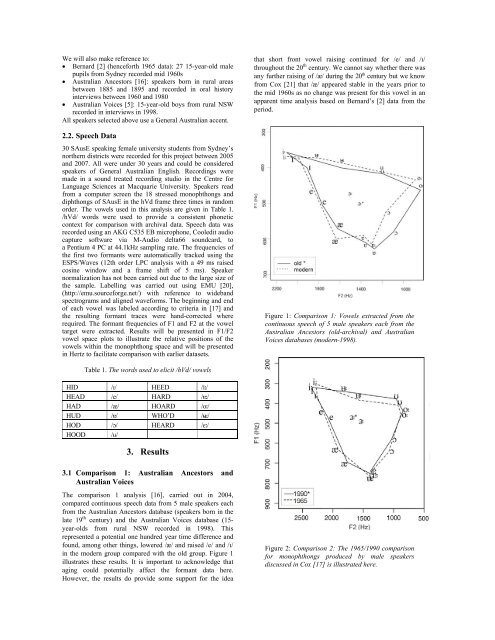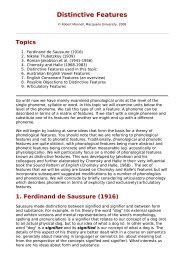Reversal of Short Front Vowel Raising in Australian English
Reversal of Short Front Vowel Raising in Australian English
Reversal of Short Front Vowel Raising in Australian English
You also want an ePaper? Increase the reach of your titles
YUMPU automatically turns print PDFs into web optimized ePapers that Google loves.
We will also make reference to:<br />
• Bernard [2] (henceforth 1965 data): 27 15-year-old male<br />
pupils from Sydney recorded mid 1960s<br />
• <strong>Australian</strong> Ancestors [16]: speakers born <strong>in</strong> rural areas<br />
between 1885 and 1895 and recorded <strong>in</strong> oral history<br />
<strong>in</strong>terviews between 1960 and 1980<br />
• <strong>Australian</strong> Voices [5]: 15-year-old boys from rural NSW<br />
recorded <strong>in</strong> <strong>in</strong>terviews <strong>in</strong> 1998.<br />
All speakers selected above use a General <strong>Australian</strong> accent.<br />
2.2. Speech Data<br />
30 SAusE speak<strong>in</strong>g female university students from Sydney’s<br />
northern districts were recorded for this project between 2005<br />
and 2007. All were under 30 years and could be considered<br />
speakers <strong>of</strong> General <strong>Australian</strong> <strong>English</strong>. Record<strong>in</strong>gs were<br />
made <strong>in</strong> a sound treated record<strong>in</strong>g studio <strong>in</strong> the Centre for<br />
Language Sciences at Macquarie University. Speakers read<br />
from a computer screen the 18 stressed monophthongs and<br />
diphthongs <strong>of</strong> SAusE <strong>in</strong> the hVd frame three times <strong>in</strong> random<br />
order. The vowels used <strong>in</strong> this analysis are given <strong>in</strong> Table 1.<br />
/hVd/ words were used to provide a consistent phonetic<br />
context for comparison with archival data. Speech data was<br />
recorded us<strong>in</strong>g an AKG C535 EB microphone, Cooledit audio<br />
capture s<strong>of</strong>tware via M-Audio delta66 soundcard, to<br />
a Pentium 4 PC at 44.1kHz sampl<strong>in</strong>g rate. The frequencies <strong>of</strong><br />
the first two formants were automatically tracked us<strong>in</strong>g the<br />
ESPS/Waves (12th order LPC analysis with a 49 ms raised<br />
cos<strong>in</strong>e w<strong>in</strong>dow and a frame shift <strong>of</strong> 5 ms). Speaker<br />
normalization has not been carried out due to the large size <strong>of</strong><br />
the sample. Labell<strong>in</strong>g was carried out us<strong>in</strong>g EMU [20],<br />
(http://emu.sourceforge.net/) with reference to wideband<br />
spectrograms and aligned waveforms. The beg<strong>in</strong>n<strong>in</strong>g and end<br />
<strong>of</strong> each vowel was labeled accord<strong>in</strong>g to criteria <strong>in</strong> [17] and<br />
the result<strong>in</strong>g formant traces were hand-corrected where<br />
required. The formant frequencies <strong>of</strong> F1 and F2 at the vowel<br />
target were extracted. Results will be presented <strong>in</strong> F1/F2<br />
vowel space plots to illustrate the relative positions <strong>of</strong> the<br />
vowels with<strong>in</strong> the monophthong space and will be presented<br />
<strong>in</strong> Hertz to facilitate comparison with earlier datasets.<br />
Table 1. The words used to elicit /hVd/ vowels<br />
HID /ɪ/ HEED /iː/<br />
HEAD /e/ HARD /ɐː/<br />
HAD /æ/ HOARD /oː/<br />
HUD /ɐ/ WHO’D /ʉː/<br />
HOD /ɔ/ HEARD /ɛː/<br />
HOOD /ʊ/<br />
3. Results<br />
3.1 Comparison 1: <strong>Australian</strong> Ancestors and<br />
<strong>Australian</strong> Voices<br />
The comparison 1 analysis [16], carried out <strong>in</strong> 2004,<br />
compared cont<strong>in</strong>uous speech data from 5 male speakers each<br />
from the <strong>Australian</strong> Ancestors database (speakers born <strong>in</strong> the<br />
late 19 th century) and the <strong>Australian</strong> Voices database (15year-olds<br />
from rural NSW recorded <strong>in</strong> 1998). This<br />
represented a potential one hundred year time difference and<br />
found, among other th<strong>in</strong>gs, lowered /æ/ and raised /e/ and /ɪ/<br />
<strong>in</strong> the modern group compared with the old group. Figure 1<br />
illustrates these results. It is important to acknowledge that<br />
ag<strong>in</strong>g could potentially affect the formant data here.<br />
However, the results do provide some support for the idea<br />
that short front vowel rais<strong>in</strong>g cont<strong>in</strong>ued for /e/ and /ɪ/<br />
throughout the 20 th century. We cannot say whether there was<br />
any further rais<strong>in</strong>g <strong>of</strong> /æ/ dur<strong>in</strong>g the 20 th century but we know<br />
from Cox [21] that /æ/ appeared stable <strong>in</strong> the years prior to<br />
the mid 1960s as no change was present for this vowel <strong>in</strong> an<br />
apparent time analysis based on Bernard’s [2] data from the<br />
period.<br />
Figure 1: Comparison 1: <strong>Vowel</strong>s extracted from the<br />
cont<strong>in</strong>uous speech <strong>of</strong> 5 male speakers each from the<br />
<strong>Australian</strong> Ancestors (old-archival) and <strong>Australian</strong><br />
Voices databases (modern-1998).<br />
Figure 2: Comparison 2: The 1965/1990 comparison<br />
for monophthongs produced by male speakers<br />
discussed <strong>in</strong> Cox [17] is illustrated here.
















